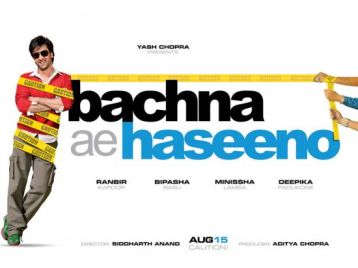
 |
 Postcard pretty settings as a backdrop for uplifting romantic encounters have become a Yashraj Productions staple established by Yash Chopra and continued by his son Aditya Chopra. In his latest production Aditya Chopra takes us to Switzerland, Australia and Italy. Of course the globetrotting links in with the producer’s idea of what will work with a younger audience – a few references to the cinema of their youth, a few gossamer brushes with tradition and then full blown immersion in the supercool of the present day. So we start in Switzerland resurrecting images of that jewel in Yashraj’s somewhat tarnished crown – Dilwale Dulhania Le Jayenge. For the traditional element there’s a brief visit to Amritsar – the heartland of the Punjab and for the cool there’s Sydney , Australia with director Siddarth Anand as our guide. If it sounds like some kind of travelogue then so be it – because the storyline is merely an excuse to get from A to B. It is filmmaking by numbers ; entertaining because Ranbir Kapoor is watchable, the music is catchy and the locales are beautifully captured but nothing more. Postcard pretty settings as a backdrop for uplifting romantic encounters have become a Yashraj Productions staple established by Yash Chopra and continued by his son Aditya Chopra. In his latest production Aditya Chopra takes us to Switzerland, Australia and Italy. Of course the globetrotting links in with the producer’s idea of what will work with a younger audience – a few references to the cinema of their youth, a few gossamer brushes with tradition and then full blown immersion in the supercool of the present day. So we start in Switzerland resurrecting images of that jewel in Yashraj’s somewhat tarnished crown – Dilwale Dulhania Le Jayenge. For the traditional element there’s a brief visit to Amritsar – the heartland of the Punjab and for the cool there’s Sydney , Australia with director Siddarth Anand as our guide. If it sounds like some kind of travelogue then so be it – because the storyline is merely an excuse to get from A to B. It is filmmaking by numbers ; entertaining because Ranbir Kapoor is watchable, the music is catchy and the locales are beautifully captured but nothing more.
Raj Sharma (Ranbir Kapoor) is a selfish, immature but hugely successful yuppy who seems to attract money and beautiful women in equal measure. We chart his journey to self-realisation by observing three stages in his life – each defined by a different woman. Kunal Kholi’s Hum Tum (2004) was structured in a similar way but concentrated on developing one relationship. Bachna Ae Haseeno gives us three sketchy and extremely predictable windows into Raj’s life, leeched of meaning because the traditional mainstays have been removed and the screenwriters don’t seem to know what to put in their place. Gone are the glorious grandmothers, self-sacrificing mothers and even the crusty fathers with sentimental hearts. Young people exist in ‘cool land’ – they ‘live-in’. It’s urban, sophisticated but devoid of charm. As a Western viewer who was drawn to Bollywood films because of their emotional, romanticized, larger -than-life family values, I find a distasteful hollowness in films that try too hard to be super-cool; presenting an adolescent view of the world without convincingly connecting lifestyle to the real nature of modern, urban life as Metro (2007) attempted to do. The film seems to be intent on creating an image for newcomer Ranbir Kapoor at all costs. As in Sawaariya (2007), he is portrayed as boyish. The first part has him playing an 18 year old which works even though the Dilwale Dulhania Le Jayenge context is less than satisfactory. Kapoor offers many a cute lift of the eyebrow and winsome, wide-eyed smile in order to channel the ‘clown’ and ‘boy’ in him. He moves very well – like someone who has been groomed for stardom from an early age, with an extremely supple spine and fluid, articulate transitions. Less attention is given to the female actors who support him – Minissha Lamba, Bipasha Basu and Deepika Padukone. The fact that they do not resonate is not just because their roles are secondary – it’s because the screenplay and direction haven’t breathed life into them. Minissha Lamba tries mightily to extract sentiment from her lines but fails – not because she is incompetent but because the odds are against her. She is portrayed as a ‘Simran wannabe’ looking for her Raj. When one’s whole presence in a film is either an act of homage to a more successful film or a repository for the patronising gestures of the leading male character, what chance does a female actor have to prove her worth? Bipasha Basu is locked into her usual sexy stereotype with some token melodramatic dialogue thrown in for good measure. Needless to say one overblown moment of insight appears forced and awkward in a sea of non-descript catwalk. Deepika Padukone has been given a career girl (Preeti Zinta without the bubbliness) kind of role which offers some dramatic moments but not fully intelligible ones. Maybe subtitle dependence has smudged my understanding of the driving force behind her character. Be that as it may, I didn’t at any stage feel as if I knew her, or that her aspirations were real.
Ironically, making references to Dilwale Dulhania Le Jayenge only serves to weaken Bachna Ae Haseeno by reminding us of the wonderfully focussed and moving relationship between the ‘real’ Raj and Simran. The former was a film that spoke of its time, addressed fears and allayed insecurities. It is fondly remembered while this latest Yashraj production will, most probably be - forgotten.
|
| Comments | Contact Us | Advertise | Terms of Service | Privacy Policy |